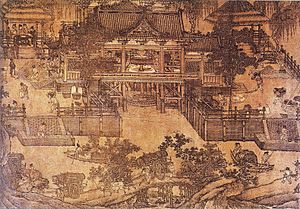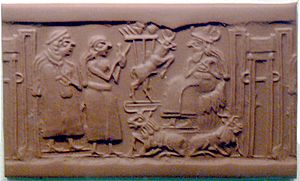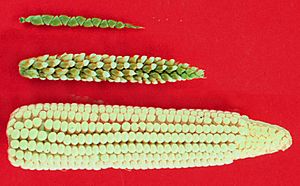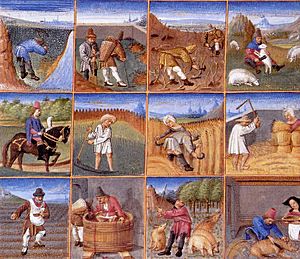History of agriculture facts for kids

Agriculture, or farming, started in many different parts of the world at different times. People began growing plants and raising animals about 12,000 years ago. This big change meant humans no longer had to move around constantly to hunt and gather food. Instead, they could build permanent homes and grow their own food.
Long before farming began, people collected wild grains for food, even as far back as 105,000 years ago. But truly growing and taming plants came much later. The first signs of people growing small amounts of edible grasses are from about 21,000 BC near the Sea of Galilee. By 9500 BC, people in the Middle East were growing eight main crops. These included emmer wheat, einkorn wheat, barley, peas, lentils, bitter vetch, chickpeas, and flax.
In China, rice was first grown around 6200 BC. Later, mung, soy, and azuki beans were also farmed. Rice was also grown independently in West Africa by 1000 BC. Animals like pigs were tamed in Mesopotamia about 11,000 years ago, followed by sheep. Cattle were tamed from wild aurochs in areas like modern Turkey and India around 8500 BC. Camels were tamed later, around 3000 BC.
In Africa, south of the Sahara Desert, crops like sorghum were tamed by 3000 BC. Pearl millet followed by 2000 BC. Yams were tamed in different places in West Africa. Cowpeas were grown by 2500 BC. Other African plants that became food include watermelon, okra, and coffee. Plantains were grown in Africa by 3000 BC and bananas by 1500 BC. The helmeted guineafowl was also tamed in West Africa.
In South America, farming started as early as 9000 BC. The potato was tamed in the Andes mountains between 8000 BC and 5000 BC. Other crops like beans, squash, tomatoes, and peanuts were also grown. Animals like llamas, alpacas, and guinea pigs were tamed. Cassava was grown in the Amazon Basin by 7000 BC. Maize (corn) came to South America from Mesoamerica. In Mesoamerica, wild teosinte was tamed into maize around 7000 BC. Cotton was grown in Peru by 4200 BC.
Sugarcane and some root vegetables were tamed in New Guinea around 7000 BC. Bananas were also grown there around the same time. In Australia, farming methods like eel traps date back to 6,600 BC.
The Bronze Age, starting around 3300 BC, saw farming grow much bigger in places like Mesopotamia, ancient Egypt, and ancient China. From 100 BC to 1600 AD, the world's population grew, and so did farming land. During the Iron Age and classical antiquity, the Roman Empire expanded farming across Europe. In the Middle Ages, new farming methods and crops spread, including sugar, rice, cotton, and oranges. After Christopher Columbus's voyages in 1492, the Columbian exchange brought new foods. Crops like maize, potatoes, and tomatoes went from the Americas to Europe. Crops like wheat, barley, and rice, and animals like horses and cattle, went from Europe to the Americas.
New farming techniques like irrigation, crop rotation, and fertilizers were used early on. They improved a lot in the last 200 years, especially during the British Agricultural Revolution. Since 1900, farming in developed countries has become much more productive. Machines replaced human labor, and synthetic fertilizers and pesticides helped crops grow better. The Haber process allowed factories to make a lot of ammonium nitrate fertilizer, which greatly increased how much food farms could produce. Modern farming has also brought up important issues about the environment and society.
Contents
The Start of Farming
Farming changed how humans lived forever. It's often called the Neolithic Revolution.
Why Did Farming Begin?
Scientists have different ideas about why farming started. They think that before people started farming, they were already collecting a lot of wild plants and staying in one place for longer periods. For example, the Natufian culture in the Middle East did this.
One popular idea for why farming started in the Middle East is climate change. After the last ice age (around 11,000 BC), many parts of the Earth had long dry seasons. This was good for plants that die in the dry season but leave behind seeds or tubers. Because there were so many easy-to-store wild grains and beans, hunter-gatherers in some areas could build the first settled villages.
How Farming Developed Early On

People started changing the plants and animals around them very early. They used methods like controlled burning and forest gardening to help useful plants grow. Wild grains were collected and eaten at least 105,000 years ago. It's hard to know exact dates because people collected seeds before they truly tamed the plants.
Farming began on its own in many different parts of the world. At least 11 separate regions in the Old World (Europe, Asia, Africa) and the New World (the Americas) were places where farming started independently. Some of the first animals to be tamed were pigs, about 10,500 years ago. Sheep were tamed in Mesopotamia between 11,000 BC and 9000 BC. Cattle were tamed around 8500 BC. Camels were tamed later, around 3000 BC.
After 9500 BC, eight main crops became important for farming. These were emmer wheat, einkorn wheat, barley, peas, lentils, bitter vetch, chickpeas, and flax. These crops appeared around the same time in the Middle East. Wheat was the first to be grown on a large scale. Around the same time (9400 BC), fig trees were also tamed.
By 8000 BC, farming was strong along the Nile River. Around this time, farming also started independently in China, with rice as the main crop. Maize (corn) was tamed from a wild grass in southern Mexico by 6700 BC. In the Americas, the potato (8000 BC), tomato, pepper (4000 BC), squash (8000 BC), and several types of beans (from 8000 BC) were tamed.
On the island of New Guinea, farming also developed on its own. Bananas were grown there as early as 5000 BC, possibly even 8000 BC.
In northern China, millet was tamed between 8000 and 6000 BC. It became the main crop in the Yellow River basin by 5500 BC. Later, mung, soy, and azuki beans were also grown.
In southern China, rice was tamed between 11,500 and 6200 BC. This led to wetland farming. Rice farming later spread to Southeast Asia. This movement also brought tamed plants from Taiwan and New Guinea to the Pacific Islands. Trade with Sri Lanka and Southern India also led to the exchange of food plants, which started the valuable spice trade.
In Africa's Sahel region, sorghum was tamed by 3000 BC in Sudan, and pearl millet by 2500 BC in Mali. Kola nut and coffee were also tamed in Africa. In New Guinea, people started farming around 7000 BC, growing sugarcane and taro. In the Indus Valley (modern-day Pakistan and India), barley and wheat were grown from 8000 BC. Animals like sheep, goats, and cattle were also tamed.
Ancient Civilizations and Farming
Sumerian Farming
Sumerian farmers grew barley and wheat. They started living in villages around 8000 BC. Because there wasn't much rain, farming depended on the Tigris and Euphrates rivers. They built irrigation canals from the rivers to water their crops. The first ploughs appeared in pictures around 3000 BC. Later, seed-ploughs that put seeds into the ground were used around 2300 BC. They also grew vegetables like chickpeas, lentils, peas, beans, onions, garlic, and lettuce. Fruits included dates, grapes, apples, melons, and figs.
Farming in Ancient Egypt
The civilization of Ancient Egypt relied heavily on the Nile River and its regular floods. The Nile's floods made the soil very fertile, which helped Egyptians become rich through farming. Egyptians were among the first to farm on a large scale, starting around 10,000 BC. They developed basin irrigation to water their fields. Their main food crops were grains like wheat and barley.
Farming in Ancient China

Records from ancient China show that farming was very important from the 5th century BC to the 2nd century AD. They had a system of grain storage across the country and widely used sericulture (raising silkworms). An important old Chinese book on farming is the Qimin Yaoshu from AD 535. This book talked about preparing land, planting, growing crops, managing orchards, and raising animals.

For farming, the Chinese invented the water-powered trip hammer by the 1st century BC. This machine helped pound and polish grain. They also started using the chain pump by the 1st century AD. This pump, powered by a waterwheel or oxen, lifted water for irrigation. By the end of the Han dynasty (late 2nd century AD), heavy ploughs with iron parts were developed. These ploughs slowly spread west and changed farming in Northern Europe by the 10th century.
Asian rice was tamed 8,200–13,500 years ago in China. It came from a single type of wild rice in the Pearl River valley. Rice farming then spread to South and Southeast Asia.
Farming in the Roman Empire
In the Roman Empire, farming built on techniques from earlier cultures like the Sumerians. Romans focused on growing crops for trade. They also set up a system where large landowners controlled their land and the workers, often peasants or serfs. Roman farms came in different sizes: small, medium, and large estates called latifundia. Romans used different ways to manage farms, including owners working with their families, slaves working under managers, or tenants sharing crops with the owner.
Farming in the Americas
Farming in the Americas was different from the Old World. The Americas didn't have large, easily tamed grains like wheat or large animals for farm work. Instead of planting one crop in a field, ancient American farming often involved growing many crops close together, using only hand labor. Also, the Americas had many different climate zones, which led to the taming of many different plants.
When Europeans first arrived, they used large-scale farming with ploughs and animals. Native Americans used intensive farming with human labor. Europeans were impressed by the productivity of Native American farming. Maize (corn) was the most important crop in the Americas. It produced much more food per acre than wheat and barley.
South American Farming
The earliest signs of farming in the Americas, around 9000 BC, are in Colombia and Ecuador. Plants like lerén, arrowroot, squash, and bottle gourd were grown. In the Andes, the main crop was the potato, tamed between 8000 and 5000 BC. Coca, peanuts, tomatoes, and pineapple were also tamed there. Animals like llamas, alpacas, and guinea pigs were tamed. The Inca Empire grew huge amounts of food and stored it in special buildings.
The most important crop tamed in the Amazon Basin was probably cassava, before 7000 BC.
Mesoamerican Farming
In Mesoamerica, wild teosinte was changed into modern maize (corn) by human selection around 7,000 BC. It spread across North and South America and was the most important crop for Native Americans. Other Mesoamerican crops included many types of squash and beans. Cocoa was also an important crop. The turkey was likely tamed in Mexico or the U.S. Southwest.
The Aztecs were active farmers. They developed irrigation systems, terraced hillsides, fertilized their soil, and created artificial islands called "floating gardens" (chinampas). The Mayas used canals and raised fields to farm swampy land.
North American Farming
Native people in the Eastern U.S. tamed many crops. These included sunflowers, tobacco, and different kinds of squash. Wild foods like wild rice and maple sugar were also collected.
A special way of planting called the Three Sisters was developed in North America. Three crops that helped each other were planted together: winter squash, maize (corn), and climbing beans. The maize gave the beans something to climb. The beans put nitrogen into the soil, which helped the other plants. The squash spread along the ground, blocking sunlight and stopping weeds from growing.
Australian Farming
Indigenous Australians were mostly nomadic hunter-gatherers. However, they also used various farming methods. In some regions, people lived in permanent settlements and planted and harvested on a large scale. They grew yams, bush onions, and native millet.
Indigenous Australians used controlled burning, called fire-stick farming, to make the land more productive. They also developed advanced eel farming and fish trapping systems. These ideas suggest that the whole continent was managed by Indigenous people.
Farming in the Middle Ages and Early Modern Period
Farming in Europe
The Middle Ages saw more improvements in farming. Monasteries became important places for farming knowledge. The manorial system allowed large landowners to control their land and workers. During this time, the Arab world played a key role in sharing crops and technology between Europe, Asia, and Africa. They brought summer irrigation to Europe and started large-scale sugarcane farming using slaves.
By AD 900, better iron production in Europe led to improved farm tools like ploughs and horseshoes. The heavy plough, based on Chinese designs, helped farmers turn over the heavy, wet soils of northern Europe. This led to more land being cleared for farming and an increase in population. Farmers also started using a three-field crop rotation system. This meant one of three fields was left empty each year. This increased productivity and nutrition, as it allowed for nitrogen-fixing plants like peas and beans.
Watermills and windmills were improved and used to grind grains, cut wood, and process flax and wool. Crops included wheat, rye, barley, and oats. Peas, beans, and vetches became common from the 13th century.
Farming in the Arab World
From the 8th to the 14th century, the Islamic world experienced a big change in farming, called the Arab agricultural revolution. This was due to new crops and plants spreading along Muslim trade routes. More advanced farming techniques also spread. This changed the economy, where people lived, and what they ate and wore. Muslim traders brought many crops to Europe through Spain, including sugar cane, rice, cotton, citrus fruits, and vegetables like eggplant and spinach. They also used intensive irrigation, crop rotation, and farming manuals.
The Columbian Exchange
After 1492, a worldwide exchange of crops and animals happened. Maize, potatoes, sweet potatoes, and cassava went from the Americas to the Old World. Wheat, barley, rice, and turnips, along with horses, cattle, sheep, and goats, went from the Old World to the Americas. This exchange caused population growth around the world.
Maize and cassava were brought from Brazil to Africa by Portuguese traders in the 16th century. They became main foods there. The potato, brought from South America to Spain in the late 1500s, became a main crop across Europe by the late 1700s. The potato allowed farmers to produce more food, which reduced disease and increased births. This led to a population boom. However, too much dependence on the potato also caused problems, like the Great Famine in Ireland when potato crops failed due to disease.
Modern Farming
The British Agricultural Revolution
Between the 17th and mid-19th centuries, Britain saw a huge increase in farming output. New practices like enclosure (fencing off land), machines, four-field crop rotation, and selective breeding helped the population grow. The amount of wheat produced per acre greatly increased.
New farming techniques began to appear in England. A big problem was that soil would lose its nutrients, especially nitrogen. To fix this, land was often left empty (fallow) or crop rotation was used. The Dutch four-field rotation system became popular. This system (wheat, turnips, barley, and clover) allowed livestock to be raised all year. Clover was important because its roots put nitrogen back into the soil.
Machines also made farming more efficient. Jethro Tull invented a seed drill in 1701 that planted seeds at the right depth and spacing. Andrew Meikle invented a threshing machine in 1784. Ploughs also improved. The first petrol-driven tractor was built in America in 1892.
Scientists also started studying fertilizers. John Bennet Lawes began researching how different fertilizers affected crop yield in 1843. He also started one of the first artificial fertilizer factories.
20th Century Farming
The first successful gasoline-powered tractor was built in 1901. By 1923, tractors were widely replacing animals like horses on farms. Since then, machines like combines and planters have been developed. These inventions allowed farming tasks to be done much faster and on a larger scale. This led to modern farms producing much more high-quality food.

The Haber process for making ammonium nitrate fertilizer was a major breakthrough. It was first patented by German chemist Fritz Haber. In 1910, Carl Bosch made the process work on a large scale for factories. After World War II, the use of synthetic fertilizer grew quickly, along with the world's population.
In the past century, farming has seen increased productivity. Synthetic fertilizers and pesticides replaced human labor. Scientific research since 1950 has also led to gene manipulation in crops and the development of biofuels.
The number of people working in farming in industrial countries dropped a lot. For example, in America, it went from 24 percent of the population to 1.5 percent in 2002. Farms also became fewer and larger.
The Green Revolution

The Green Revolution was a big effort from the 1940s to the late 1970s. It involved research and new technologies that greatly increased farming production around the world. Led by Norman Borlaug, this effort is credited with saving over a billion people from starvation. It involved creating new types of high-yielding grains, expanding irrigation, and giving farmers new management techniques, hybrid seeds, synthetic fertilizers, and pesticides.
Synthetic nitrogen, along with mined rock phosphate, pesticides, and machines, greatly increased crop yields in the 20th century. This led to more food being available. The Green Revolution brought these technologies from developed countries to developing countries. While some people worried that the Earth couldn't feed its growing population, technologies like the Green Revolution helped the world produce a surplus of food.
Organic Farming
For most of history, farming was "organic." This means it didn't use synthetic fertilizers, pesticides, or genetically modified organisms (GMOs). When chemical agriculture started, some people called for farming without synthetic pesticides. This led to the development of organic farming, which is now practiced in many countries around the world.
Images for kids
-
Indigenous Australian camp by Skinner Prout, 1876.
-
An ear of barley, a symbol of wealth in the ancient Greek city of Metapontum.
See also
 In Spanish: Historia de la agricultura para niños
In Spanish: Historia de la agricultura para niños






















